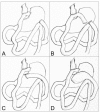Laparoscopic revisional surgery for an unusual complication of Roux-en-Y gastric bypass
- PMID: 29930168
- PMCID: PMC6020929
- DOI: 10.1136/bcr-2018-224759
Laparoscopic revisional surgery for an unusual complication of Roux-en-Y gastric bypass
Abstract
With the worldwide epidemic of obesity, there has been an increase in the numbers of primary and revisional procedures of bariatric surgery such as the Roux-en-Y gastric bypass (RYGBP). Nevertheless, this type of surgery is not exempt from complications. An excessive length of non-functional Roux limb proximal to the jejunojejunostomy can cause abnormal upper gastrointestinal symptoms after laparoscopic RYGBP. We present the case of a female patient who presented these unspecific abdominal symptoms after laparoscopic RYGBP who underwent laparoscopic resection in order to reduce the length of the dilated blind loop responsible for the symptoms.
Keywords: gastrointestinal surgery; malabsorption.
© BMJ Publishing Group Ltd (unless otherwise stated in the text of the article) 2018. All rights reserved. No commercial use is permitted unless otherwise expressly granted.
Conflict of interest statement
Competing interests: None delared.
Figures



Similar articles
-
Intussusception After Roux-en-Y Gastric Bypass: Laparoscopic Management.Obes Surg. 2018 Jul;28(7):2145-2147. doi: 10.1007/s11695-018-3265-1. Obes Surg. 2018. PMID: 29675635
-
"Candy cane syndrome:" an underappreciated cause of abdominal pain and nausea after Roux-en-Y gastric bypass surgery.Surg Obes Relat Dis. 2017 Sep;13(9):1501-1505. doi: 10.1016/j.soard.2017.04.006. Epub 2017 Apr 8. Surg Obes Relat Dis. 2017. PMID: 28552743
-
Revision of failed laparoscopic adjustable gastric banding to Roux-en-Y gastric bypass.Obes Surg. 2006 Feb;16(2):137-41. doi: 10.1381/096089206775565212. Obes Surg. 2006. PMID: 16469213
-
Gastric bypass: why Roux-en-Y? A review of experimental data.Arch Surg. 2007 Oct;142(10):1000-3; discussion 1004. doi: 10.1001/archsurg.142.10.1000. Arch Surg. 2007. PMID: 17938315 Review.
-
GASTROGASTRIC FISTULA AFTER ROUX-EN-Y GASTRIC BYPASS: A CASE REPORT AND REVIEW OF LITERATURE.Arq Bras Cir Dig. 2020;33(2):e1509. doi: 10.1590/0102-672020190001e1509. Epub 2020 Aug 24. Arq Bras Cir Dig. 2020. PMID: 32844882 Free PMC article. Review. No abstract available.
References
-
- World Health Organization. WHO | obesity and overweight [Internet]. 2018. http://www.who.int/mediacentre/factsheets/fs311/en/
-
- Prieto AMR, Martínez MA, Vargas ME, et al. . Bypass gástrico “simplificado” – 150 casos. Cirujano General 2010;32:76–82.
Publication types
MeSH terms
LinkOut - more resources
Full Text Sources
Other Literature Sources
Medical
Research Materials
